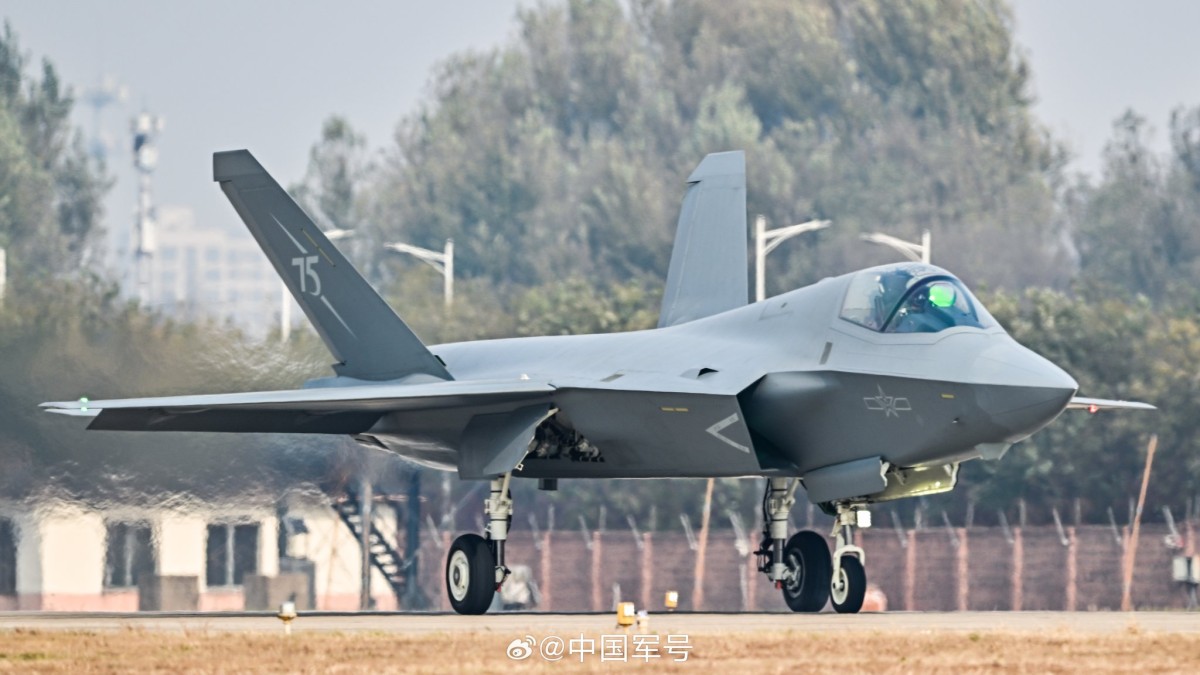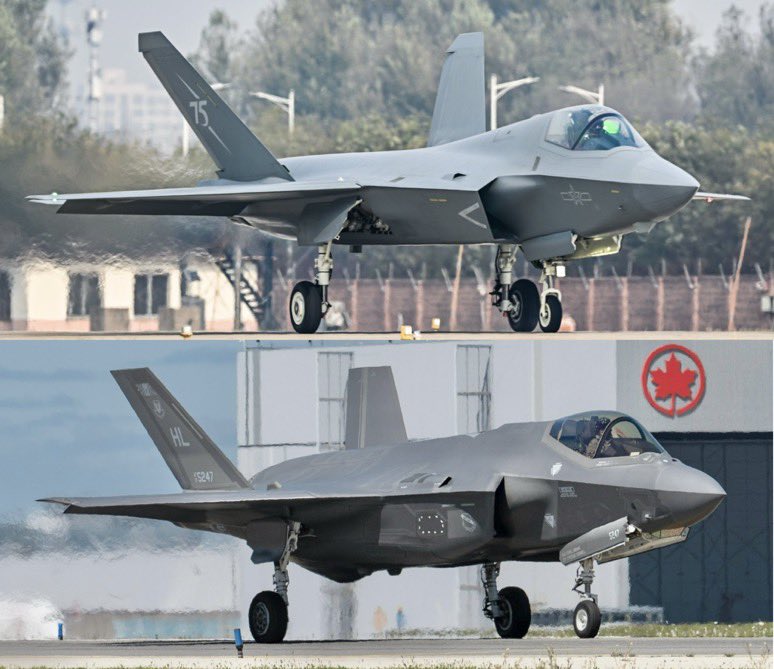The Chinese People’s Liberation Army (PLA) Air Force has officially unveiled its latest stealth fighter jet, the J-35A, and announced plans for its debut at Airshow China 2024. The Airshow China 2024 is scheduled to be held from November 12 to 17 in Zhuhai, South China’s Guangdong Province.
A photo released on November 5 during an Air Force press conference provided the first look at this advanced aircraft, a key addition to China’s expanding air capabilities.
Chinese state-run Global Times reported that the PLA’s announcement of the J-35A suggests the aircraft is now operational and meets the Air Force’s standards for technical performance, safety, and reliability.
The J-35A’s anticipated debut signals a major step forward in China’s military aviation sector, positioning it as a strong player in stealth technology and multi-role combat capabilities.
This announcement comes shortly after an image of the J-35A’s tail surfaced online on November 4, stirring considerable speculation within military circles. The photo showed the tail marked with the number “75,” likely to commemorate the PLA Air Force’s 75th anniversary.
Originally shared by the Chinese People’s Liberation Army (PLA) News Media Center on the popular Chinese social media platform Weibo, the image quickly gained traction when military aviation researcher @RupprechtDeino reposted it on X (formerly known as Twitter).
Russia’s “Nuclear Time Bomb” Is Ticking; Divers Inspect Nuke Submarine That Sank 42 Years Ago

Accompanying the image, the China Bugle, the official media account of the PLA’s News Media Center, teased the public with a post titled “Super spoilers! Is the J-35 officially announced?”
This intrigued the audience, as it suggested that this was an official image of the eagerly awaited aircraft. It also hinted at a reveal at the upcoming Airshow China 2024, stating, “Do not rush. We will see you in Zhuhai in 3+5 days.”
With the release of a new image on November 5, it has been confirmed that the PLAAF’s land-based variant is now designated as the J-35A, while the carrier-borne version with wing-folding capability will likely be referred to as the J-35.
The carrier-based J-35 fighter aircraft has already been in the news following its recent tests aboard the People’s Liberation Army Navy (PLAN) Type 001 aircraft carrier, Liaoning.
Notably, this would be China’s second fifth-generation stealth fighter jet after the Chengdu J-20. Until now, the US is the only country in the world that boasts two fifth-generation stealth fighter jets: the Lockheed Martin F-22 Raptor and F-35 Lightning II.
This year, the People’s Republic of China is celebrating the 75th anniversary of its founding, and November 11 marks the 75th anniversary of the establishment of the PLA Air Force.
The number “75” on the tail thus honors the PLA Air Force’s 75-year history, which began on November 11, 1949.
China’s J-35 Fighter Aircraft
China’s J-35 stealth fighter is under development to serve both the People’s Liberation Army Navy Air Force (PLANAF) and the People’s Liberation Army Air Force (PLAAF), aimed at expanding China’s aerial capabilities across its military branches. However, detailed insights into the aircraft’s full capabilities are scarce.
Chinese media sources, citing experts, regularly suggest that the J-35 could rival the US Lockheed Martin F-35 Lightning II in performance, indicating an ambition to achieve parity with top-tier Western stealth fighters.
The J-35A differs in design from China’s first stealth fighter, the J-20. The J-20, featuring a canard wing configuration, is a heavyweight fighter designed primarily for air superiority missions, comparable to the US F-22.
In contrast, the J-35A is a medium-sized fighter with a tailplane wing configuration similar to the US F-35. It is also equipped with surface attack capabilities.

A Chinese military expert commented on the newly released image of the J-35A, stating, “In my opinion, the J-35 is the world’s most stealthy fighter jet and is fully capable of rivaling and suppressing its opponents.”
Reports regarding the J-35 first appeared in June 2020, describing it as a more advanced and “production-ready” iteration of the earlier FC-31 model.
These reports noted design enhancements, including smoother contours, a larger radome to accommodate an improved radar system, and better-aligned control surfaces to minimize the aircraft’s radar signature.
The carrier-capable variant of the J-35, derived from the FC-31, made its inaugural flight on October 29, 2021. This model has a wing-fold mechanism, an essential feature for operation from aircraft carriers.
Initially, it was believed that the J-35 was being engineered for deployment on the Type 003 Fujian, China’s third aircraft carrier, which will be Beijing’s first aircraft carrier to utilize an electromagnetic catapult launch system.
However, the fighter jet has recently undergone testing on China’s first aircraft carrier, Liaoning. The Liaoning and China’s second aircraft carrier, the Shandong, employs ski-jump ramps for launching aircraft, primarily operating the J-15 fighter.
The introduction of the J-35 indicates its potential deployment on these carriers despite the inherent limitations of ski-jump launches compared to catapult-assisted systems.
On September 18, Chinese state media confirmed that the J-35 successfully took off and landed on the aircraft carrier Liaoning. That announcement marked the first official acknowledgment of its operational capabilities aboard a carrier.
The prototypes of the FC-31/J-35 are believed to be equipped with RD-93 engines, but there are ongoing efforts to develop an improved WS-13E engine, which is expected to provide around 22,000 pounds of thrust.
This new engine is projected to eventually replace the RD-93 in the FC-31, enhancing the aircraft’s performance and operational capabilities.
Moreover, the FC-31 is designed to support a payload capacity of 18,000 pounds. Internally, it can accommodate munitions weighing up to 4,400 pounds, allowing for a variety of weapon systems to be housed within the airframe.
Externally, the aircraft features six hard points that can carry an additional 13,000 pounds of armament, further extending its strike capabilities.
While specific details about the production and total quantity of the J-31 stealth fighter remain difficult to ascertain, the ongoing development of a carrier-launched variant holds the promise of significantly strengthening China’s naval aviation capabilities.
Currently, the Chinese military grapples with a considerable gap in capabilities compared to the US Navy, which fields advanced aircraft such as the carrier-launched F-35C and the F-35B used by the Marine Corps.
These platforms offer unmatched versatility and lethality, allowing for superior air dominance in maritime operations. In contrast, China’s existing naval aviation assets are still in the process of transitioning to a more modern fleet.
International Interest in China’s Stealth Fighter
There is increasing foreign interest in a land-based version of the FC-31, which is also known as the export variant. Early this year, the Chief of the Pakistan Air Force announced plans to acquire an undisclosed number of FC-31 fighters, indicating a strong market potential for this platform.
In August, EurAsian Times reported that pilots from the Pakistan Air Force (PAF) have started training on the Chinese FC-31 Gyrfalcon fighter aircraft.
The demand for medium-weight combat aircraft featuring stealth capabilities or significant signature reduction appears to be thriving. The South Korean KF-21 Boramae and the Turkish TF Kaan are leading examples of a transformative shift in military aviation.
As nations strive to enhance their air power, many are moving away from older fourth-generation fighter jets, opting instead for more advanced models that provide exceptional performance and state-of-the-art technology.
These next-generation aircraft are designed with stealth features that allow for greater operational effectiveness in contested environments.
FC-31 is particularly relevant for nations unable to procure the F-35 or those seeking to circumvent the stringent export restrictions that often accompany it.
Should China succeed in providing an enhanced version of the FC-31 at a significantly lower price point than its rivals, it could potentially attract interest from a broader range of customers beyond the Pakistan Air Force.
This competitive pricing strategy may open doors to various nations looking for capable, cost-effective alternatives in the medium-weight stealth fighter market.
Potential customers for the FC-31 may also emerge in the Middle East. In February, China showcased a prototype model at the World Defence Show in Saudi Arabia.
During the event, a Chinese official mentioned that while the aircraft is not yet operational within the PLA Air Force, it is anticipated to enter service soon. According to media reports, Egypt is also interested in the acquisition of Chinese stealth jets.
- Contact the author at ashishmichel(at)gmail.com
- Follow EurAsian Times on Google News




